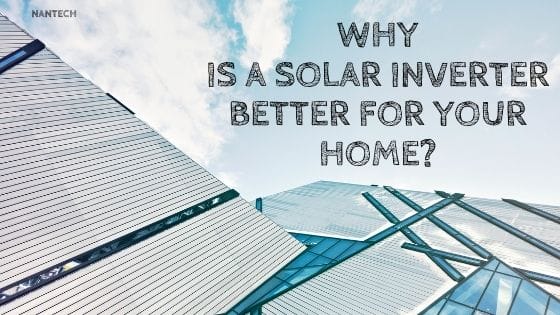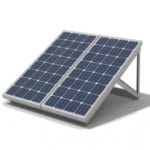- Home
- About us
- Products
- Dealer Enquiry
- Contact Us
- 044 -2486 1994
- +91 99623 98222
- sales@nantech.in
- REQUEST A QUOTE

With the continually increasing concerns of global warming, there has been a lot of awareness about using clean energy. Solar energy is one such form of renewable, affordable, and inexhaustible energy that we can extract from nature and, in a way, for nature. However, setting up a whole new solar energy system with many options available can be baffling. Opting for solar energy set up requires a fixed commitment and long-term investment. Therefore, it's necessary to do little homework before choosing the solar plant you wish to install. Solar plants are of two types an on-grid solar plant and an off-grid solar plant. An on-grid solar plant generates electricity and is directly connected to the utility power grid.
On the other hand, the off-grid solar grid does not work in conjunction with the utility grid. Instead, they are connected to batteries, which store the power generated by them. Chennai, being a coastal region, often suffers from gloomy and cloudy days. If an on-grid solar panel is the only source of electricity, there could be times when the consumers will have to suffer from power cuts making an already gloomy day gloomier.
When it comes to such rainy, cyclone-prone areas, using an on-grid solar plant is not an extremely reliable option. To curb this problem, Nantech Power Systems Pvt. Ltd, a company based in Chennai, has got you covered. Having expertise in manufacturing power equipment, this company is like a ray of light to fill your ill-lit days with dazzle and sparkle.
Off-grid solar plants work independently of the grid. They have the following components :
The solar panels absorb solar energy, and the excess energy is stored in the batteries. This stored energy from a previously sunny day can be used when the sun has set or during cloudy days when there is no sun at all. These are self-sufficient power providers in areas where power grids remain unavailable, like in rural and remote areas, where they can provide electricity for a long time or in areas where there are frequent power cuts. Another advantage of an off-grid solar plant is that any mishaps like grid failures or shutting down of grids during stormy weathers do not prevent them from supplying energy since they are independent of the utility grids. Therefore, they are autonomous, unstoppable, and infallible. An additional advantage of using the off-grid solar plant is that you don't have to pay any electricity bill if you are using only one energy source that is of your solar plant.
One disadvantage of the off-grid solar plant is that if there are abnormally dark days in a row, the energy stored in the battery may get exhausted, limiting its use. Another disadvantage is that they are costlier to install. However, one should note that the number of benefits an off-grid solar plant has overridden the costs of installing it. Thus, by choosing it, you are self-sufficient and fulfilling your duty as a responsible inhabitant of the planet.

Today, fossil fuels and their by-products are being scrutinized by the world, and the focus is more on greener and environmentally friendly sources of energy. Solar Energy, mainly the use of Solar panels, has gained much traction in this field, It uses Solar Photovoltaic (PV) Cells to capture sunlight and convert that to electricity.
However one must remember that solar panels usually provide Direct Current (DC) energy. Most of our household electrical appliances use Alternating Current (AC) energy. Thus, we need to convert DC to AC, and this is where we use a solar inverter. This device converts the output current from the solar panels to AC energy, which can be used in your house.
Also Read: Aspects To Consider While Purchasing A Solar Inverter
Today, there are three types of Solar Inverter technologies that one can choose from:
In a PV system with a string inverter, the panels are wired together with 'strings,' Each panel's output can be sent back to the central inverter via this 'string.' This allows for a low-cost inverter operation and is durable and easy to maintain. These are best suited for houses with simple roofs that get sun throughout the day and for people looking for an economical and low-cost PV system.
 These are different from the string inverter system, and here, the solar panels each have a small inverter installed. Therefore, the conversion from DC to AC occurs right on the roof. The advantage of this system is that for systems that experience shading or have more complex designs, one can use this instead of a string system to mitigate the problems. Furthermore, it allows for panel-level monitoring since each microinverter is connected to the solar panels. These are usually high-cost, high-performance inverters, and hence one must use them for complicated roof constructions.
These are different from the string inverter system, and here, the solar panels each have a small inverter installed. Therefore, the conversion from DC to AC occurs right on the roof. The advantage of this system is that for systems that experience shading or have more complex designs, one can use this instead of a string system to mitigate the problems. Furthermore, it allows for panel-level monitoring since each microinverter is connected to the solar panels. These are usually high-cost, high-performance inverters, and hence one must use them for complicated roof constructions.
These fall in between microinverters and string inverters. These are interfaces located near (or on) the solar panels, which 'condition' the DC output and send it back to a centralized inverter. The advantage is that it helps monitor individual panels, mitigate the impact of shading, optimize the efficiency of inverters, and cost less than microinverters. These are best suited for houses or buildings with less ideal solar panel locations and whose owners are willing to pay a little extra for a better system but don't want microinverters.
Nantech Power Systems Pvt. Ltd provides the best inverters to buy in India, with its excellent product line-up, efficient services, and timely after-sales support. Check it out!